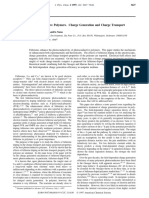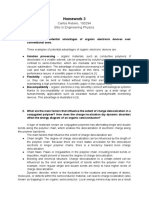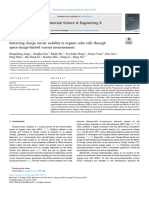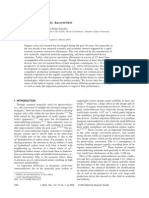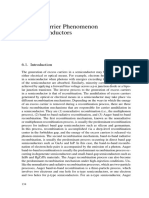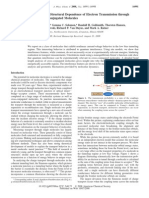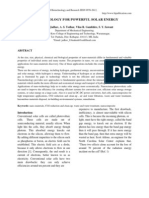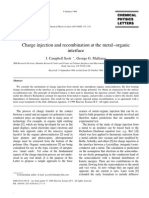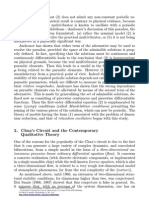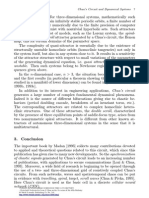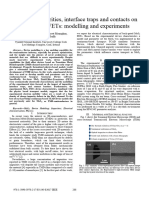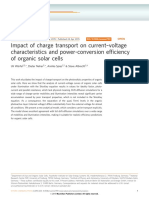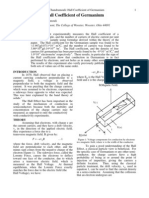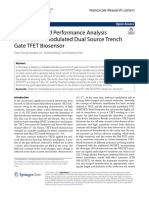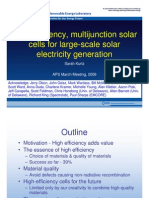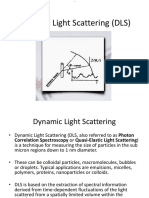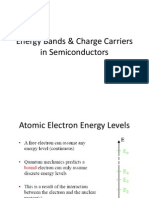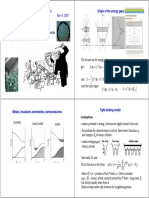76.JApplPhys 107 084503 PDF
76.JApplPhys 107 084503 PDF
Uploaded by
AjayaKumarKavalaCopyright:
Available Formats
76.JApplPhys 107 084503 PDF
76.JApplPhys 107 084503 PDF
Uploaded by
AjayaKumarKavalaOriginal Title
Copyright
Available Formats
Share this document
Did you find this document useful?
Is this content inappropriate?
Copyright:
Available Formats
76.JApplPhys 107 084503 PDF
76.JApplPhys 107 084503 PDF
Uploaded by
AjayaKumarKavalaCopyright:
Available Formats
The effect of carrier mobility in organic solar cells
Ji-Ting Shieh,
1
Chiou-Hua Liu,
2
Hsin-Fei Meng,
3,a
Shin-Rong Tseng,
3
Yu-Chiang Chao,
3
and Sheng-Fu Horng
2
1
Institute of Photonics Technologies, National Tsing Hua University, Hsinchu 300, Taiwan, Republic of
China
2
Institute of Electronics Engineering, National Tsing Hua University, Hsinchu 300, Taiwan, Republic of
China
3
Institute of Physics, National Chiao Tung University, Hsinchu 300, Taiwan, Republic of China
Received 24 November 2009; accepted 21 January 2010; published online 21 April 2010
The microscopic states and performance of organic solar cell are investigated theoretically to
explore the effect of the carrier mobility. With Ohmic contacts between the semiconductor and the
metal electrodes there are two origins of carriers in the semiconductor: the photocarriers generated
by photon absorption and the dark carriers diffused from the electrodes. The power efciency of the
solar cell is limited by the recombination of a carrier with either the photocarrier or a dark carrier.
Near the short-circuit condition the photocarrier recombination in the semiconductor bulk decreases
as the mobility increases. Near the open-circuit condition the dark carrier recombination increases
with the mobility. These two opposite effects balance with one another, resulting in an optimal
mobility about 10
2
cm
2
/ V s which gives the highest power conversion efciency. The balance of
the electron and hole mobilities are not necessary to maintain the optimal efciency also because of
the balance of the photocarrier and dark carrier recombination. The efciency remains about the
same as one carrier mobility is xed at 10
2
cm
2
/ V s while the other one varies from 10
1
to
10
3
cm
2
/ V s. For solar cell with a Schottky barrier between the semiconductor and the metal
electrode there is no dark carrier recombination. The efciency therefore always increases with the
mobility. 2010 American Institute of Physics. doi:10.1063/1.3327210
I. INTRODUCTION
Organic solar cells have attracted great attention recently
because of their unique properties such as the potential for
high efciency, easy solution process for low cost fabrica-
tion, and the application for the exible devices. Bulk hetro-
junctions BHJs of organic solar cells use the mixture of
donor and acceptor components in the bulk so that the pro-
cess of exciton diffusion to the charge separation donor-
acceptor interface is efcient. The power conversion ef-
ciency PCE exceeding 5% of organic BHJ solar cell has
been reported.
1,2
Much effort in experiments have been made
to improve the performance of the device recently, but the
efciency remains around 5%.
36
Obviously there remain
many fundamental questions regarding to the origins of ef-
ciency limitation and the device concept to raise the perfor-
mance. In addition, theoretical methods are established to
understand the physical process of the BHJ solar cell more
clearly. There are four processes that contribute to the ef-
ciency of the organic BHJ solar cell, including the absorption
of photons and the creation of excitons, exciton diffusion to
the charge separation interface, exciton dissociation to free
electron and hole by the heterojunctions, and carrier trans-
port and collection by the electrodes.
7
Among the factors, the
photon absorption reaches 90% with the thickness of the
active layer larger than 200 nm,
1
and the exciton dissociation
can be very efcient due to the large amounts of charge
separation interfaces in the BHJ solar cells. The key factor to
decide the efciency is the process of carriers transport and
collection by the electrodes. Therefore the carrier mobility is
a critical factor to determine the efciency. Some theoretical
models are established for the organic solar cell. The optimal
mobility on organic solar cell was discussed in previous
works.
811
The notion of quasi-Fermi level was introduced
and the difference between the electron and hole Fermi lev-
els was shown to decrease as the mobility increases.
8
The
quasi-Fermi level is however just another expression of the
open-circuit voltage, and there were no studies on what hap-
pens to the carrier density and recombination prole with
increasing mobility. The exciton dissociation rate into free
electron-hole pair was shown to be limited by geminate
recombination
9,12
and depends on the mobility. Such
mobility-dependent dissociation was incorporated into the
device model.
10
The exciton dissociate rate is however near
unity for mobility over 10
3
cm
2
/ V s,
8
so this effect is ex-
pected to play a minor role for high mobility. Surface recom-
bination was raised as one possibility for efciency reduction
at high mobility.
11
Such model requires a surface recombina-
tion velocity as an extra parameter whose microscopic origin
is not clear. In addition, it is unlikely for the minority carrier
to reach the electrode interface because of the strong recom-
bination with the majority carrier near the interface, as dis-
cussed below. A distribution in the binding energy of charge-
transfer state, as a precursor to free electron-hole pair, was
considered as a possible source of mobility dependence of
efciency.
11
The energy of the charge-transfer state is deter-
mined by the energy levels of donor and acceptor. There
would be a wide range of such energy only when there was a
a
Author to whom correspondence should be addressed. Electronic mail:
meng@mail.nctu.edu.tw.
JOURNAL OF APPLIED PHYSICS 107, 084503 2010
0021-8979/2010/1078/084503/9/$30.00 2010 American Institute of Physics 107, 084503-1
Downloaded 20 May 2010 to 140.113.20.240. Redistribution subject to AIP license or copyright; see http://jap.aip.org/jap/copyright.jsp
mixture of materials. The mobility-dependent transfer among
the charge-transfer state is therefore not expected to have a
major effect on the solar cell with a single donor and a single
acceptor material.
It is expected that the majority of the effects of the mo-
bility is not derived from the secondary factors such as ex-
citon dissociation and surface recombination but lie within
the essential model with only drift-diffusion current, unit ex-
citon dissociation probability, and Langevin
recombination.
9,13
Recombination is known to be the domi-
nant factor to limit the efciency and the effect of mobility
should enter through recombination. It is clear that recombi-
nation increases in the low mobility limit because of the
photocarrier accumulation inside the bulk. What happens to
the recombination in the high mobility limit is however less
known. There is so far no clear and complete understanding
of the effect of mobility on the recombination and more gen-
erally microscopic physical state of the solar cell and the
overall conversion efciency. It is generally believed that the
improvement of the efciency requires a high mobility be-
cause of an easier photocarrier extraction. However it is not
known whether there exist an optimal mobility at which the
efciency reaches a maximum within the essential model. In
this work we employ a microscopic numerical model for a
comprehensive study on the effect of carrier mobility on the
recombination of organic solar cell. The distributions of car-
rier density, recombination rate, and electric eld are calcu-
lated as functions of the mobility for various voltages. Both
the cases of symmetrical electron-hole mobility and the un-
symmetrical mobilities are considered. The energy barrier
height between the semiconductor and the metal electrodes is
varied.
Once an electron-hole pair is created by photon absorp-
tion, there are three possible nal destinations for the elec-
tron. It can either be collected by the low work function
cathode, or recombine with a hole, or collected by the high
work function anode. Below we will name the cathode as the
right electrode for the electron and anode the wrong elec-
trode. The destinations for the hole are similar. Only the
electrons collected by the right electrode contribute to the
desired photocurrent for power conversion. In our calcula-
tion for Ohmic contact the wrong electrode collection is neg-
ligible so the most important limit for the solar cell ef-
ciency is the carrier recombination. For an electron it can
recombine with holes from two origins, one is the photoge-
neration and another is the diffusion from the high work
function anode. The carriers which come from the electrode
diffusion are called dark carriers because they are present
even without illumination. The total recombination can
therefore be viewed as a combination of photocarrier recom-
bination and dark carrier recombination. Near the short-
circuit condition the high built-in electric eld prevents the
dark carriers from entering the bulk of the semiconductor so
the dark carriers concentrate around the semiconductor metal
interface. On the other hand near the open-circuit condition
there is almost a at energy band so the dark carriers easily
penetrate inside the bulk. Interestingly the photocarrier re-
combination and dark carrier recombination have opposite
dependence on the carrier mobility. At low mobility the pho-
tocarriers accumulate inside the bulk and its density is high
resulting in high recombination. At high mobility the dark
carrier diffusion from the metal to the semiconductor be-
comes rapid resulting in high dark carrier recombination.
Our calculation shows that at low voltage the photocurrent is
lower for low mobility case because of strong photocarrier
recombination, while the open-circuit voltage V
OC
is lower
for high mobility case because of the predominant dark car-
rier recombination. The two opposite effects of the mobility
give an optimal mobility where the efciency reaches a
maximal, in contrast to the general concept that the increase
in mobility is also benecial for the solar cell.
The behaviors of the solar cell change dramatically as
the Ohmic contact is replaced by a Schottky contact with
large energy barrier. Our calculation shows that there are no
longer dark carriers because of the energy barrier so the re-
combination is dominated by the photocarrier recombination.
The solar cell efciency then monotonically increases with
the carrier mobility because of the rapid motion toward the
electrodes under built-in eld. Furthermore the collection by
the wrong electrode becomes important with Schottky con-
tact. Indeed with Ohmic contact it is difcult for an electron
to reach the high work function anode because of the high
density of holes around the interface, so recombination will
occurs before reaching the interface. However for Schottky
contact there in no such hole layer near the anode so the
electrons can reach both sides, especially near the open-
circuit condition where the band is nearly at and the carrier
motions are driven by diffusion rather than electric eld.
Even though Ohmic contact is always preferred in practice
because of the optimal open-circuit voltage, the theoretical
comparison with the Schottky contact provides a great in-
sight on the origins of effect of carrier mobility on the re-
combination processes and the overall efciency.
II. MODEL AND EQUATION
In this work we calculate the distributions of the carrier
density, recombination, electron and hole current density, and
potential energy in the device to investigate the effect of
carrier mobility. The current voltage relation under solar il-
lumination gives the ll factor FF, PCE, short-circuit cur-
rent J
SC
, and open-circuit voltage V
OC
. By deriving the
continuity equation at steady state the total current density J
t
is expressed as
dJ
n
qdx
= G R, 1
J
n
0 J
n
L =
qG qRdx, 2
J
n
0 J
n
L = J
g
J
r
. 3
The same reason
J
p
L J
p
0 = J
g
J
r
. 4
The denition of total current is given by
J
t
= J
n
0 + J
p
0 = J
n
L + J
p
L, 5
084503-2 Shieh et al. J. Appl. Phys. 107, 084503 2010
Downloaded 20 May 2010 to 140.113.20.240. Redistribution subject to AIP license or copyright; see http://jap.aip.org/jap/copyright.jsp
J
t
J
r
= J
n
0 J
p
0 J
r
. 6
Substitution Eq. 3 into Eq. 6
J
t
J
r
= J
n
L J
p
0 J
g
, 7
J
t
J
r
= J
1
+ J
2
J
g
, 8
J
t
= J
1
+ J
2
J
g
+ J
r
, 9
where J
1
J
2
is the electrical current density of electrons
holes entering the anode cathode as shown in Fig. 1a, J
g
is photogeneration current density, and J
r
is the recombina-
tion current density resulted from dark carrier recombination
and photocarrier recombination as shown in Fig. 1b. G is
the photocarrier generation rate by sunlight, which is taken
constant with respect to the position for simplicity. The re-
combination rate R has a bimolecular form R=np with the
Langenvin recombination coefcient given by
14,15
=
4e
n
+
p
. 10
The dark carriers are the carriers diffused from the metal to
the semiconductor. Dark carrier recombination means the
dark carriers recombine with the photocarriers. The positive
electrical current is dened to be the one owing to the left
side in Fig. 1a. In solar cell the electrical current ows to
the right so it is negative in our calculations below. Both J
g
and J
r
are positive by denition. J
1
and J
2
are also both
positive because at the wrong interface the carriers can only
leave the semiconductor because of the extremely large in-
jection barriers from the metal side. The generation current is
therefore compromised by the three terms in Eq. 9, result-
ing from the carrier recombination, and electron entering the
anode, and the hole entering the cathode. J
1
, J
2
, and J
r
are
mobility dependent.
The theoretical model is based on the previous works on
organic light-emitting diodes.
16,17
We choose physical pa-
rameters from the system of poly3-hexylthiophene-2,5-diyl
P3HT donor and 6,6-phenyl C61 butyric acid methyl es-
ter PCBM acceptor blend, and the electron afnity of
PCBM is 3.7 eV and the ionization potential of P3HT is 5.1
eV. All values of the physical variables in the thermal equi-
librium can be solved by equilibrium carrier density expres-
sion coupled with Poissons equation. The thermal equilib-
rium is taken as the initial condition for the time evolution to
state under illumination and applied voltage. The equilibrium
equations are given as following:
n = n
0
e
E
C
exE
F
, 11
p = n
0
e
E
F
exE
V
, 12
2
x
2
x
=
qp n
, 13
where =1/ kT, n
0
is the density of state of the semiconduc-
tor, E
c
is the energy of the band conduction band, E
V
is the
energy of the valance band, x is electric potential, x is the
position coordinate, E
F
is the Fermi level, is the semicon-
ductor dielectric constant, and q is the absolute value of elec-
tron charge. The bias voltage is applied within a voltage
ramp and the system reaches the steady state afterwards. The
steady state is treated by solving iteratively the continuity
Eqs. 14 and 15 and Poissons Eq. 13. As shown in Eqs.
16 and 17, the currents are combination of drift and dif-
fusion terms current relations and Poissons equation
n
t
=
1
q
J
n
x
+ G R, 14
p
t
=
1
q
J
p
x
+ G R, 15
J
n
= qnE +
kT
q
n
x
, 16
J
p
= qnE
kT
q
p
x
. 17
J
n
and J
p
are the electron and hole current densities, respec-
tively. The mobility is assumed to be eld independent and
symmetrical for electron and hole initially. The ow chart of
simulation program is shown in Fig. 2. The boundary condi-
tion is determined by the carrier injection at the contact. The
total hole electrical current density J
p
is given by
18
(a) (b)
Anode
Cathode
recombination
(b) (a)
Dark carrier :
Photo carrier :
injection
(i) (ii)
Electron:
Hole :
J
2
= -J
P
(0)
J
1
= - J
n
(L)
Anode
Cathode
FIG. 1. a Schematic diagram of the carriers collected by the wrong elec-
trodes. J
1
J
2
is the electrical current of electron hole collected by the
anode cathode. b Recombination paths for photocarriers in the active
layer. Path i is the recombination between dark carriers and photocarriers.
Path ii is the recombination among photocarriers themselves.
Time evolution iteration
Thermo equilibrium
Drift-diffusion
current formula
Constant
G
Result
Rearranged time-differential
Poisson equation
Error check
yes
Continuity
equation
Update the recombination
n
int
p
int
E
int
E
new
R
new
n
new
p
new
J
new
no
FIG. 2. Flow diagram of the simulation program. At rst, the thermal equi-
librium solution is solved to get the initial condition in time evolution. Then,
the bias voltage is applied within a pseudotime so that the steady state is
reached. The steady state is treated by solving the continuity equation
coupled with drift-diffusion current relations and Poissons equation
iteratively.
084503-3 Shieh et al. J. Appl. Phys. 107, 084503 2010
Downloaded 20 May 2010 to 140.113.20.240. Redistribution subject to AIP license or copyright; see http://jap.aip.org/jap/copyright.jsp
J
t
x = J
device
= J
th
J
ir
, 18
Where J
th
is thermionic emission current given by
J
th
= AT
2
exp
B
kT
. 19
A is the Richardson constant,
B
=
B0
qE / 4 is the
Schottky barrier height including image force barrier lower-
ing. The interface recombination current is proportional to
the carrier density at the contact, and is given by
J
ir
= px, 20
where can be determined by balance of thermionic emis-
sion current and interface recombination current in thermal
equilibrium, with the result =AT
2
/ n
0
.
III. IN OHMIC CONTACT DEVICES WITH BALANCE OF
THE ELECTRON AND HOLE MOBILITIES
We rst apply the model to the case of low barrier height
between the metal Fermi level and the semiconductor energy
bands i.e., the Ohmic contact. The barrier height of carrier
injection is chosen to be 0.2 eV and symmetric on both sides.
The lowest unoccupied molecular orbital LUMO of the
semiconductor and the highest occupied molecular orbital
HOMO of semiconductor act as valence and conduction
band of the semiconductor to describe the blend of donor and
acceptor. The conduction band is 3.7 eV, the valance band is
5.1 eV, and generation G is 3.14510
21
. The J
t
V relation
under different carrier mobilities from 10
1
to 10
3
cm
2
/ V s
is shown in Fig. 3. V
OC
is the voltage with zero current. It
decreases dramatically as the mobility increases, resulting
from the serious dark carrier recombination when carrier mo-
bility is high.
13
It shows different behaviors between short-
circuit condition at 0 V and at band condition about 0.6 V.
At the short-circuit condition the recombination occurs
mostly near semiconductor and electrode interface and there
is less recombination in the bulk, shown in Fig. 4. The re-
combination near the electrode can be regarded as dark car-
rier recombination. The strong built-in voltage in short-
circuit condition prevents the dark carriers from diffusing
deeply to the bulk as shown in Figs. 5 and 6. Away from the
recombination in the bulk can be regarded as photocarrier
recombination. When carrier mobility increases the photocar-
riers recombination in the bulk reduces dramatically. Photo-
carriers with low mobility are difcult to transport and be
collected by electrodes. They accumulate in the bulk and
recombine with other photocarriers. Nevertheless the recom-
bination current at the short-circuit condition contributes
only small loss to the total current. At at band condition, the
recombination occurs seriously not only near the electrode
but also in the bulk, as shown in Fig. 7. In this condition the
photocarrier recombination decreases and dark carrier re-
combination increases as the mobility rises. The competition
of the two trends leads to that both low mobility
10
3
cm
2
/ V s and high mobility 10
1
cm
2
/ V s contrib-
utes to major current loss. The calculation predicts that the
carrier mobility about 10
2
cm
2
/ V s gives the balance and
optimal device performance. Near the open-circuit condition
the dark carriers diffuse easily to bulk and the dark carrier
0.0 0.1 0.2 0.3 0.4 0.5 0.6 0.7 0.8 0.9
-10
-5
0
5
10
15
PCE=3.75%
PCE=2.8%
T
o
t
a
l
c
u
r
r
e
n
t
d
e
n
s
i
t
y
(
m
A
/
c
m
2
)
Voltage (V)
Carrier mobility
(cm
2
/Vs)
10
-1
10
-2
10
-3 PCE=3.52%
FIG. 3. Color online The calculation of total current density as a function
of applied voltage with thickness of 230 nm and barrier height 0.2 eV for
various mobilities.
0 50 100 150 200
10
19
10
20
10
21
10
22
10
23
R
e
c
o
m
b
i
n
a
t
i
o
n
R
a
t
e
(
c
m
-
3
s
-
1
)
Position x (nm)
Carrier mobility
(cm
2
/V s)
10
-1
10
-2
at V=0(V)
10
-3
FIG. 4. Color online The recombination distribution for various mobilities
with barrier height 0.2 eV at short-circuit condition.
0 50 100 150 200
10
10
10
11
10
12
10
13
10
14
10
15
10
16
10
17
10
18
H
o
l
e
D
e
n
s
i
t
y
(
c
m
-
3
)
Position x (nm)
Carrier mobility (cm
2
/V s) 10
-1
10
-2
at V=0 (V)
10
-3
FIG. 5. Color online The hole density distribution for various mobilities in
the bulk with barrier height 0.2 eV at short-circuit condition.
0 50 100 150 200
10
10
10
11
10
12
10
13
10
14
10
15
10
16
10
17
10
18
E
l
e
c
t
r
o
n
D
e
n
s
i
t
y
(
c
m
-
3
)
Position x(nm)
10
-1
10
-2
at V=0(V)
10
-3
Carrier mobility (cm
2
/Vs)
FIG. 6. Color online The electron density distribution for various mobili-
ties in the bulk with barrier height 0.2 eV at short-circuit condition.
084503-4 Shieh et al. J. Appl. Phys. 107, 084503 2010
Downloaded 20 May 2010 to 140.113.20.240. Redistribution subject to AIP license or copyright; see http://jap.aip.org/jap/copyright.jsp
density is higher than the short-circuit condition, as shown in
Figs. 8 and 9. Figures 10 and 11 show the potential energy
proles of the short-circuit condition and at band condition.
The diffusion of dark carriers creates the band bending
which is stronger near V
OC
. The potential prole is nearly
independent on mobility.
IV. IN OHMIC CONTACT DEVICES WITH UNBALANCE
OF THE ELECTRON AND HOLE MOBILITIES
Until now we set hole mobility to be equal to electron
mobility and determine the mobility around 10
2
cm
2
/ V s
for optimal solar cell efciency. The optimal mobility results
from the competition between the dark carrier recombination
and the photocarrier recombination under the Ohmic contact
condition. For more practical situation, we consider the case
with distinct values of hole and electron mobility. The elec-
tron mobility is xed to be 10
2
cm
2
/ V s which is the best
value for symmetrical, and the hole mobility increases from
10
4
to 10
1
cm
2
/ V s. The results are shown in Fig. 12 and
summarized in Table I. As proportion of the hole mobility to
the electron mobility from 0.1 to 10 the efciency remains
nearly the same. Fixing the hole mobility as 10
2
cm
2
/ V s
and change electron mobility will lead to the same result
because the system symmetry. Therefore we predict that the
efciency remains high if one kind of carrier mobility is
about 10
2
cm
2
/ V s and the other is within a wide safe
range from 10
1
to 10
3
cm
2
/ V s. This is different from the
common view that the electron and hole mobility should be
about the same.
19
The preliminary experimental data of
0 50 100 150 200
10
19
10
20
10
21
Carrier mobility
(cm
-2
/V s)
10
-1
10
-2
at V=0.6(V)
10
-3
R
e
c
o
m
b
i
n
a
t
i
o
n
R
a
t
e
(
c
m
-
3
s
e
c
-
1
)
Position x (nm)
FIG. 7. Color online The recombination distribution for various mobilities
in the bulk with barrier height 0.2 eV at at band condition.
0 50 100 150 200
10
10
10
11
10
12
10
13
10
14
10
15
10
16
10
17
10
18
Carrier mobility
(cm
2
/V s)
10
-1
10
-2
at V=0.6(V)
10
-3
H
o
l
e
D
e
n
s
i
t
y
(
c
m
-
3
)
Position x (nm)
FIG. 8. Color online The hole density distribution for various mobilities in
the bulk with barrier height 0.2 eV at at band condition.
0 50 100 150 200
10
10
10
11
10
12
10
13
10
14
10
15
10
16
10
17
10
18
E
l
e
c
t
r
o
n
D
e
n
s
i
t
y
(
c
m
-
3
)
Position x (nm)
Carrier mobility
(cm
2
/V s)
10
-1
10
-2
at V=0.6(V)
10
-3
FIG. 9. Color online The electron density distribution for various mobili-
ties in the bulk with barrier height 0.2 eV at at band condition.
0 50 100 150 200
0.0
0.2
0.4
0.6
0.8
1.0 Carrier mobiltiy
(cm
2
/V s)
10
-1
10
-2
at V=0(V)
10
-3
P
o
t
e
n
t
i
a
l
E
n
e
r
g
y
(
e
V
)
Position x (nm)
FIG. 10. Color online The potential energy distribution for various mo-
bilities in the bulk with barrier height 0.2 eV at short-circuit condition.
0 50 100 150 200
0.00
0.05
0.10
0.15
0.20
0.25
0.30
0.35
0.40
Carrier mobility
(cm
2
/V s)
10
-1
10
-2
at V=0.6(V)
10
-3
P
o
t
e
n
t
i
a
l
E
n
e
r
g
y
(
e
V
)
Positon x (nm)
FIG. 11. Color online The potential energy distribution for various mobili-
ties in the bulk with barrier height 0.2 eV at at band condition.
0.0 0.1 0.2 0.3 0.4 0.5 0.6 0.7 0.8 0.9
-15
-10
-5
0
5
10
15
20
25
T
o
t
a
l
C
u
r
r
e
n
t
D
e
n
s
i
t
y
(
m
A
/
c
m
2
)
Voltage (V)
e
=10
-2
h
=10
-1
e
=10
-2
h
=10
-2
e
=10
-2
h
=10
-3
e
=10
-2
h
=10
-4
Carrier mobility
(cm
2
/V s)
FIG. 12. Color online Calculated total current density as a function of
applied voltage with thickness of 230 nm and barrier height 0.2 eV for
unbalance of hole and electron mobility.
084503-5 Shieh et al. J. Appl. Phys. 107, 084503 2010
Downloaded 20 May 2010 to 140.113.20.240. Redistribution subject to AIP license or copyright; see http://jap.aip.org/jap/copyright.jsp
polymer-based solar cells fabricated by high hole mobility
polymers also show no superior efciency even more work
still needed to be done.
20
Again the high tolerance of the
ratio between electron and hole mobility is due to the bal-
ance of the opposite effect of mobility on photocarrier re-
combination and dark carrier recombination. With unequal
mobilities the recombination coefcient is
=
q
min
n
,
p
. 21
The slow carrier determines the recombination process in the
bulk because the fast carrier should wait for the slow one to
recombine.
21
Figure 13 shows the recombination rate in the
bulk with different mobility ratio. If the ratio is larger than
100, it shows strong recombination in the bulk. Figure 14
shows the hole density distribution in the bulk. There is al-
ways a high hole density near anode due to the dark carrier
diffusion. The hole carrier density increases in the bulk uni-
formly as hole mobility is decreasing because of the slow
collection of the photocarrier. Figure 15 shows the electron
density, the distributions are about the same when the ratios
of electron and hole mobility are from 0.1 to 10. Once the
hole mobility decreases to 10
4
cm
2
/ V s with mobility ratio
100, the electron density distribution becomes higher due to
the attractive potential from accumulated holes in the bulk.
In other words, the accumulation of slows holes will eventu-
ally holds the electrons in the bulk.
V. IN SCHOTTKY CONTACT DEVICES
To eliminate the effect of the dark recombination and
isolate the effect of photocarrier recombination, we consider
the device with Schottky contact. The J
t
V relation is shown
in Fig. 16 and the inset is the recombination current density
TABLE I. The device performance for singer layer structure with xed electron mobility and various hole
mobilities. FF is ll factor and PCE is the power conversion efciency.
Mobility
cm
2
/ V s
V
OC
V
J
SC
mA/ cm
2
J
r
at V=0V
mA/ cm
2
FF
%
PCE
%
e
=10
2
h
=10
1
0.62 10.8 4.110
1
58 3.93
e
=10
2
h
=10
2
0.63 10.4 8.010
1
57 3.72
e
=10
2
h
=10
3
0.68 10.6 5.610
1
51 3.73
e
=10
2
h
=10
4
0.70 9.4 1.9 43 2.83
0 50 100 150 200
10
17
10
18
10
19
10
20
10
21
Carrier mobility
(cm
2
/V s)
e
=10
-2
h
=10
-1
e
=10
-2
h
=10
-2
e
=10
-2
h
=10
-3
e
=10
-2
h
=10
-4
R
e
c
o
m
b
i
n
a
t
i
o
n
R
a
t
e
(
c
m
-
3
s
e
c
-
1
)
FIG. 13. Color online The recombination distribution with barrier height
0.2 eV for unbalance of hole and electron mobility at short-circuit condition.
0 50 100 150 200
10
12
10
14
10
16
10
18
e
=10
-2
h
=10
-1
e
=10
-2
h
=10
-2
e
=10
-2
h
=10
-3
e
=10
-2
h
=10
-4
H
o
l
e
D
e
n
s
i
t
y
(
c
m
-
3
)
Position x (nm)
Carrier mobiliy
(cm
2
/V s)
FIG. 14. Color online The hole density distribution with barrier height 0.2
eV for unbalance of hole and electron mobility. The bias condition is short-
circuit condition.
0 50 100 150 200
10
11
10
13
10
15
10
17
e
=10
-2
h
=10
-1
e
=10
-2
h
=10
-2
e
=10
-2
h
=10
-3
e
=10
-2
h
=10
-4
E
l
e
c
t
r
o
n
D
e
n
s
i
t
y
(
c
m
-
3
)
Position x (nm)
Carrier mobility
(cm
2
/V s)
FIG. 15. Color online The electron density distribution with barrier height
0.2 eV for unbalance of hole and electron mobility. The bias condition is
short-circuit condition.
0.0 0.2 0.4 0.6 0.8 1.0
0
1
2
3
4
5
6
7
J
r
(
m
A
/
c
m
2
)
Voltage(volt)
Carrier mobility
(cm2/V s)
10-1
10-2
10-3
0.0 0.2 0.4 0.6 0.8 1.0
-12
-10
-8
-6
-4
-2
0
2
4
T
o
t
a
l
c
u
r
r
e
n
t
d
e
n
s
i
t
y
(
m
A
/
c
m
2
)
Voltage (V)
Carrier mobility
(cm
2
/V s)
10
-1
10
-2
10
-3
PCE=6.51%
PCE=5.88%
PCE=3.83%
FIG. 16. Color online The calculation of total current density as a function
of applied voltage with thickness of 230 nm and barrier height 1 eV for
various mobilities. The inset shows the recombination current.
084503-6 Shieh et al. J. Appl. Phys. 107, 084503 2010
Downloaded 20 May 2010 to 140.113.20.240. Redistribution subject to AIP license or copyright; see http://jap.aip.org/jap/copyright.jsp
J
r
. Unlike the Ohmic contact case the behaviors V
OC
is about
the same with various mobilities because there is no dark
recombination in the Schottky contact. The total currents
show different behaviors at short-circuit condition especially
when the mobility is as low as 10
3
cm
2
/ V s. In this case
the total current is only limited by the photocarrier recombi-
nation and the current entering the wrong electrode accord-
ing to Eq. 9. The photocarrier recombination becomes
strong when the mobility is low due to the photocarrier ac-
cumulation in the bulk. The generation rate G is taken to be
the same as the Ohmic contact case. In Fig. 17 the distribu-
tion of carrier recombination rate is shown to be large and
uniform in the bulk. The carrier recombination decreases as
mobility increases. There is no dark carrier in Schottky con-
tact therefore the recombination is not pronounced near the
electrodes. For further details the distribution of the electron
density nx and hole density px are shown in Figs. 18 and
19, respectively. The electron density and hole density de-
crease when the carrier mobility increases. When the mobil-
ity is high, the photocarriers can easily transport and be col-
lected by the electrodes, with little carrier accumulation in
the bulk. In this case the carriers collected by the wrong
electrodes, i.e., J
1
and J
2
in Eq. 9 and Fig. 1a become
important factors to decide the total current. Figure 20 shows
J
1
V relation. As mobility increases J
1
becomes higher near
the at band voltage. J
1
always nearly zero at short-circuit
voltage because the built-in voltage prevents the carriers
from collection by the wrong electrodes. The value of J
1
and
J
2
under different mobilities and positions are summarized in
Table II. The values of J
1
and J
2
are almost one-third of the
short-circuit current density J
SC
for carrier mobility
10
1
cm
2
/ V s shown in Fig. 16 and are become a source of
great loss. The electron current density at at band condition
for various mobilities is shown in Fig. 21. As the mobility
increases, the photocarriers are collected quickly by both the
right electrodes and the wrong electrodes the right part of
Fig. 21. The recombination distribution in at band condi-
tion is shown in Fig. 22. As the mobility increases the pho-
torecombination decreases, as the case of short-circuit con-
dition in Fig. 17. The electron and hole carrier density
distribution at at band voltage are shown in Figs. 23 and 24,
respectively. The distribution of the carrier density become
more uniform compared with that at short-circuit voltage
shown in Figs. 18 and 19 because there is no built-in voltage
in at band condition. The potential energy of short-circuit
voltage and at band voltage are shown in Figs. 25 and 26.
The potential energy remains nearly straight at both condi-
tions with different carrier mobilities due to the high injec-
tion barrier height.
The performance of BHJ solar cell depends on the mo-
bility as well as the energy levels of the donor and
acceptors.
2224
The short-circuit current density is mostly de-
termined by the acceptor band gap whereas the open-circuit
voltage determined by the difference between the HOMO
level of the donor and the LUMO level of the acceptor. It is
generally accepted that in the optimal case there is an offset
around 0.5 eV between the LUMO levels of the donor and
acceptor for efciency exciton dissociation, and the donor
band gap is around 1.9 eV as a compromise between absorp-
tion and open-circuit voltage. The ideal efciency is 10%
under the assumption of unity external quantum efciency
0 50 100 150 200
10
15
10
16
10
17
10
18
10
19
10
20
Carrier mobility
(cm
2
/V s)
10
-1
10
-2
at V=0(V)
10
-3
R
e
c
o
m
b
i
n
a
t
i
o
n
R
a
t
e
(
c
m
-
3
s
e
c
-
1
)
Position x (nm)
FIG. 17. Color online The recombination distribution for various mobili-
ties in the bulk with Schottky contact at short-circuit condition.
0 50 100 150 200
10
11
10
12
10
13
10
14
10
15
Carrier mobility
(cm
2
/V s)
10
-1
10
-2
at V=0(V)
10
-3
E
l
e
c
t
r
o
n
D
e
n
s
i
t
y
(
c
m
-
3
)
Position x (nm)
FIG. 18. Color online The electron density for various mobilities in the
bulk with Schottky contact at short-circuit condition.
0 50 100 150 200
10
11
10
12
10
13
10
14
10
15
Carrier mobility
(cm
2
/V s)
10
-1
10
-2
at V=0(V)
10
-3
H
o
l
e
D
e
n
s
i
t
y
(
c
m
-
3
)
Position x (nm)
FIG. 19. Color online The electron density for various mobilities in the
bulk with Schottky contact at short-circuit condition.
0.0 0.2 0.4 0.6 0.8 1.0
0
1
2
3
4
5
6
7
Carrier mobility
(cm
2
/V s)
10
-1
10
-2
10
-3
J
1
(
m
A
/
c
m
2
)
Voltage (V)
FIG. 20. Color online J
1
as a function of applied voltage.
084503-7 Shieh et al. J. Appl. Phys. 107, 084503 2010
Downloaded 20 May 2010 to 140.113.20.240. Redistribution subject to AIP license or copyright; see http://jap.aip.org/jap/copyright.jsp
for photons above band gap and xed FF of 0.65.
22
Experi-
mentally 6% PCE is observed due to recombination which
reduces the quantum efciency and the ll factor. The ideal
levels are in fact quite close the most commonly used donor
P3HT and acceptor PCBM Ref. 24 which are leading in
terms of efciency despite of huge amount of new materials
with other energy levels developed. In addition to energy
levels mobility has been expected to be another major pa-
rameter to be optimized and recombination is thought to be
possibly reduced with higher mobility. This work shows that
the efciency cannot be raised much by increasing mobility
because of the dark carrier recombination. Increasing the en-
ergy barrier between metal and semiconductor will reduce
the dark carrier recombination but sacrice the light absorp-
tion. Our new nding in this work is therefore that for an
optimal energy level it is impossible for improve the ef-
ciency much beyond the current value by increasing the mo-
bility because of the dark carrier recombination.
VI. CONCLUSION
In conclusion we establish a numerical model to describe
the microscopic properties and electrical characteristics of
BHJ organic solar cells. By the analysis of the distribution of
carrier density and recombination rate density it is shown
that the PCE is limited by both the recombination with the
photocarriers and recombination with dark carriers diffused
from the metal electrode. The two recombination processes
have opposite dependence on the carrier mobility. The best
efciency can be reached if one kind of carrier mobility is
about 10
2
cm
2
/ V s and the other is within a tolerance range
TABLE II. The current caused by photocarriers collected by the wrong
electrodes at at band with mobility from 10
1
to 10
3
cm
2
/ V s.
V=0.9 V
Mobility
cm
2
/ V s
J
1
mA/ cm
2
J
2
mA/ cm
2
10
1
3.31 3.31
10
2
2.78 2.78
10
3
1.87 1.88
0 50 100 150 200
-4
-2
0
2
4
6
8
Carrier mobility
(cm
2
/V s)
10
-1
10
-2
at V=0.9(V)
10
-3
T
o
t
a
l
e
l
e
c
t
r
e
o
n
c
u
r
r
e
n
t
d
e
n
s
i
t
y
(
m
A
/
c
m
2
)
Position x (nm)
FIG. 21. Color online The electron density current distribution in the bulk
with Schottky contact at at band condition.
0 50 100 150 200
10
16
10
17
10
18
10
19
10
20
10
21
R
e
c
o
m
b
i
n
a
t
i
o
n
R
a
t
e
(
c
m
-
3
s
e
c
-
1
)
Position x (nm)
Carrier mobility
(cm
2
/V s)
10
-1
10
-2
at V=0.9(V)
10
-3
FIG. 22. Color online The recombination distribution for various mobili-
ties with Schottky contact at at band condition.
0 50 100 150 200
10
11
10
12
10
13
10
14
10
15
Carrier mobility
(cm
2
/V s)
10
-1
10
-2
at V=0.9(V)
10
-3
E
l
e
c
t
r
o
n
D
e
n
s
i
t
y
(
c
m
-
3
)
Position x (nm)
FIG. 23. Color online The electron density for various mobilities with
Schottky contact at at band condition.
0 50 100 150 200
10
11
10
12
10
13
10
14
10
15
Carrier mobility
(cm
2
/V s)
10
-1
10
-2
at V=0.9(V)
10
-3
H
o
l
e
D
e
n
s
i
t
y
(
c
m
-
3
)
Position x (nm)
FIG. 24. Color online The hole density for various mobilities with
Schottky contact at at band condition.
0 50 100 150 200
0.0
0.2
0.4
0.6
0.8
1.0
Carrier mobility
(cm
2
/V s)
10
-1
10
-2
at V=0(V)
10
-3
P
o
t
e
n
t
i
a
l
E
n
e
r
g
y
(
e
V
)
Position x (nm)
FIG. 25. Color online The potential energy as a function of position for
various mobilities with Schottky contact at short-circuit condition.
084503-8 Shieh et al. J. Appl. Phys. 107, 084503 2010
Downloaded 20 May 2010 to 140.113.20.240. Redistribution subject to AIP license or copyright; see http://jap.aip.org/jap/copyright.jsp
from 10
1
to 10
3
cm
2
/ V s. The detrimental effect of dark
carriers can only be avoided by a high energy barrier be-
tween the metal and the semiconductor. Unfortunately in
practice with xed semiconductor energy bands such barrier
corresponds to a smaller metal work function difference a
reduced open-circuit voltage. Our calculation predicts that
with the inevitable dark carrier recombination for Ohmic
contact there is not too much room for further efciency
improvement by simply tuning the material parameters such
as the mobility and band gap. A more dramatic new device
concept which simultaneously solves the dark carrier prob-
lem and the open-circuit problem is required to raise the
organic solar cell efciency far beyond the current value of
around 6%.
ACKNOWLEDGMENTS
This work is supported by the National Science Council
of Taiwan under Grant Nos. NSC96-2120-M-007-007 and
NSC96-2112-M-009-036.
1
G. Li, V. Shrotriya, J. Huang, Y. Yao, T. Moriarty, K. Emery, and Y. Yang,
Nature Mater. 4, 864 2005.
2
L. Ma, C. Y. Yang, X. Gong, K. Lee, and A. J. Heeger, Adv. Funct. Mater.
15, 1617 2005.
3
G. Li, V. Shrotriya, Y. Yao, and Y. Yang, J. Appl. Phys. 98, 043704 2005.
4
Y. Kim, S. A. Choulis, J. Nelson, D. D. C. Bradley, S. Cook, and J. R.
Durrant, J. Mater. Sci. 40, 6 2005.
5
F. Padinger, R. S. Rittberger, and N. S. Sariciftci, Adv. Funct. Mater. 13,
85 2003.
6
J. Nakamura, K. Murata, and K. Takahashi, Appl. Phys. Lett. 87, 132105
2005.
7
P. W. M. Blom, V. D. Mihailetchi, L. J. A. Koster, and D. E. Markov, Adv.
Mater. 19, 1551 2007.
8
M. Mandoc, L. Koster, and P. Blom, Appl. Phys. Lett. 90, 133504 2007.
9
L. Koster, E. Smits, V. Mihailetchi, and P. Blom, Phys. Rev. B 72, 085205
2005.
10
C. Deibel, A. Wagenpfahl, and V. Dyakonov, Phys. Status Solidi RRL 2,
175 2008.
11
T. Kirchartz, B. Pieters, K. Taretto, and U. Rau, Phys. Rev. B 80, 035334
2009.
12
C. Braun, J. Chem. Phys. 80, 4157 1984.
13
Y. X. Wang, S. R. Tseng, H. F. Meng, K. C. Lee, C. H. Liu, and S. F.
Horng, Appl. Phys. Lett. 93, 133501 2008.
14
P. Langevin, Ann. Chim. Phys. 28, 433 1903.
15
U. Albrecht and H. Bassler, Chem. Phys. 199, 207 1995.
16
M. J. Tsai and H. F. Meng, J. Appl. Phys. 97, 114502 2005.
17
C. H. Chen and H. F. Meng, Appl. Phys. Lett. 86, 201102 2005.
18
P. S. Davids, I. H. Campbell, and D. L. Smith, J. Appl. Phys. 82, 6319
1997.
19
A. M. Goodman and A. Rose, J. Appl. Phys. 42, 2823 1971.
20
J. E. Parmer, A. C. Mayer, B. E. Hardin, S. Scully, M. D. McGehee, M.
Heeney, and I. McCulloch, Appl. Phys. Lett. 92, 113309 2008.
21
L. J. A. Koster, V. D. Mihailetchi, and P. W. M. Blom, Appl. Phys. Lett.
88, 052104 2006.
22
M. Scharber, D. Muhlbacher, M. Koppe, P. Denk, C. Waldauf, A. Heeger,
and C. Brabec, Adv. Mater. 18, 789 2006.
23
K. Coakley and M. McGehee, Chem. Mater. 16, 4533 2004.
24
L. Koster, V. Mihailetchi, and P. Blom, Appl. Phys. Lett. 88, 093511
2006.
0 50 100 150 200
0.01
0.02
0.03
0.04
0.05
0.06
0.07
0.08
Carrier mobility
(cm
2
/V s)
10
-1
10
-2
at V=0.9(V)
10
-3
P
o
t
e
n
t
i
a
l
E
n
e
r
g
y
(
e
V
)
Position(nm)
FIG. 26. Color online The potential energy as a function of position for
various mobility with Schottky contact at at band condition.
084503-9 Shieh et al. J. Appl. Phys. 107, 084503 2010
Downloaded 20 May 2010 to 140.113.20.240. Redistribution subject to AIP license or copyright; see http://jap.aip.org/jap/copyright.jsp
You might also like
- MOSFET Short Channel EffectsDocument11 pagesMOSFET Short Channel EffectsPranali A JadhavNo ratings yet
- Energy & Environmental Science: CommunicationDocument6 pagesEnergy & Environmental Science: CommunicationBhabani Sankar SwainNo ratings yet
- 3 s2.0 B9780080453125500443 MainDocument9 pages3 s2.0 B9780080453125500443 MainEzgi GeyikNo ratings yet
- Magnetic Fields: A Tool For The Study of Organic Solar CellsDocument10 pagesMagnetic Fields: A Tool For The Study of Organic Solar CellsGheymisson BrennoNo ratings yet
- Seventeen, Jun 2011Document5 pagesSeventeen, Jun 2011emediageNo ratings yet
- APEX MD MechElectrDocument4 pagesAPEX MD MechElectrJosh LansiganNo ratings yet
- 1997-1 Fullerenes in Photoconductive Polymers. Charge Generation and Charge TransportDocument12 pages1997-1 Fullerenes in Photoconductive Polymers. Charge Generation and Charge TransportDoktor transmisionesNo ratings yet
- Introduction To Organic Solar CellsDocument6 pagesIntroduction To Organic Solar CellsMohammad BagherNo ratings yet
- Tomomi Shimazaki Et Al - A Theoretical Study of Molecular Conduction. III. A Nonequilibrium-GreensfunctionDocument12 pagesTomomi Shimazaki Et Al - A Theoretical Study of Molecular Conduction. III. A Nonequilibrium-GreensfunctionGomsajNo ratings yet
- Current Opinion in Colloid & Interface Science: Juan A. AntaDocument8 pagesCurrent Opinion in Colloid & Interface Science: Juan A. AntaA. S.LNo ratings yet
- Current Opinion in Colloid & Interface Science: Juan A. AntaDocument8 pagesCurrent Opinion in Colloid & Interface Science: Juan A. AntaA. S.LNo ratings yet
- Watkins 2005Document5 pagesWatkins 2005mani_vlsiNo ratings yet
- Lección de Historia Del Arte Del Profesor Robles by SlidesgoDocument11 pagesLección de Historia Del Arte Del Profesor Robles by SlidesgoretheeshvkmNo ratings yet
- 2.11.1 Introduction - Simple Recombination Model: Fig.2.11.1 Carrier Recombination Mechanisms in SemiconductorsDocument7 pages2.11.1 Introduction - Simple Recombination Model: Fig.2.11.1 Carrier Recombination Mechanisms in SemiconductorsWahyu SipahutarNo ratings yet
- Seminar PSCDocument30 pagesSeminar PSCsujithrasuji773No ratings yet
- Hybrid Solar CellDocument19 pagesHybrid Solar CellankurpratimsaikiaNo ratings yet
- How Is The Efficiency of Solar Panels Affected by The P-Type and N-Type Carrier Concentration in Semiconductors?Document5 pagesHow Is The Efficiency of Solar Panels Affected by The P-Type and N-Type Carrier Concentration in Semiconductors?International Journal of Innovative Science and Research Technology100% (1)
- Homework 3 NN2021Document7 pagesHomework 3 NN2021CarlosNo ratings yet
- Carrier Generation and RecombinationDocument4 pagesCarrier Generation and RecombinationTasnim RahmanNo ratings yet
- Aerospace: Modeling Plasma Via Electron Impact IonizationDocument25 pagesAerospace: Modeling Plasma Via Electron Impact IonizationProjesh BasuNo ratings yet
- Organic Solar Cell PDFDocument9 pagesOrganic Solar Cell PDFFeiTenNo ratings yet
- Ideality Factor For PN Junction DiodeDocument5 pagesIdeality Factor For PN Junction Dioderahul05singhaNo ratings yet
- Semiconductor Clusters NanocryDocument4 pagesSemiconductor Clusters NanocryPablo PerezNo ratings yet
- On The Dynamics of ChargingDocument8 pagesOn The Dynamics of ChargingFaysal Rahman SunbirNo ratings yet
- 1 s2.0 S0927796X24000020 MainDocument12 pages1 s2.0 S0927796X24000020 Mainalemdar CIANo ratings yet
- PCCP SolarcellDocument10 pagesPCCP SolarcellRageh HusseinNo ratings yet
- TCAD Based Simulation and Performance Optimization of PPV/PCBM and Perovskite PV CellsDocument7 pagesTCAD Based Simulation and Performance Optimization of PPV/PCBM and Perovskite PV Cellsfr wsaibNo ratings yet
- Akimov 2013Document70 pagesAkimov 2013edupibosNo ratings yet
- Essay On Conducting PolymersDocument7 pagesEssay On Conducting Polymerssjktnknsjgrg100% (1)
- Organic Solar Cell - An OverviewDocument22 pagesOrganic Solar Cell - An Overviewapi-3745529100% (2)
- Zeta Potential: A New ApproachDocument12 pagesZeta Potential: A New Approachelektron2010No ratings yet
- Excess Carrier Phenomenon in SemiconductorsDocument2 pagesExcess Carrier Phenomenon in SemiconductorsDr. KhidhirBrahmendra VNo ratings yet
- Revital Cohen Et Al - Charge Transport in Conjugated Aromatic Molecular Junctions: Molecular Conjugation and Molecule-Electrode CouplingDocument10 pagesRevital Cohen Et Al - Charge Transport in Conjugated Aromatic Molecular Junctions: Molecular Conjugation and Molecule-Electrode CouplingHumdsNo ratings yet
- Multi-Junction Solar Cell: From Wikipedia, The Free EncyclopediaDocument13 pagesMulti-Junction Solar Cell: From Wikipedia, The Free EncyclopediaAryan KhannaNo ratings yet
- Module 3: Polymer Solar Cell Teacher Background and ResourcesDocument12 pagesModule 3: Polymer Solar Cell Teacher Background and Resourcesapi-298708900No ratings yet
- Nat EnergyDocument14 pagesNat Energyminjie815No ratings yet
- Quantum Interference: The Structural Dependence of Electron Transmission Through Model Systems and Cross-Conjugated MoleculesDocument8 pagesQuantum Interference: The Structural Dependence of Electron Transmission Through Model Systems and Cross-Conjugated MoleculesDfmso0No ratings yet
- Device Simulation of Highly Efficient Eco Friendly CH NH Sni Perovskite Solar CellDocument11 pagesDevice Simulation of Highly Efficient Eco Friendly CH NH Sni Perovskite Solar CelleniNo ratings yet
- Brus 1984Document8 pagesBrus 1984Eduardo CarmineNo ratings yet
- Charge Transport Through Molecular Switches: Home Search Collections Journals About Contact Us My IopscienceDocument31 pagesCharge Transport Through Molecular Switches: Home Search Collections Journals About Contact Us My IopscienceChriszandro HofmeisterNo ratings yet
- Energy & Environmental Science: PaperDocument8 pagesEnergy & Environmental Science: PaperBhabani Sankar SwainNo ratings yet
- Ncomms 5774Document8 pagesNcomms 5774Samuel ColtNo ratings yet
- Artigo JMMDocument11 pagesArtigo JMMMaurício FalleirosNo ratings yet
- ZetaDocument10 pagesZetaDiana Codreanu SiretanuNo ratings yet
- Visualizing Electron Rearrangement in Space and Time During The Transition From A Molecule To AtomsDocument4 pagesVisualizing Electron Rearrangement in Space and Time During The Transition From A Molecule To AtomsMNo ratings yet
- ECE730 OSCReviewDocument40 pagesECE730 OSCReviewkhannoussi kamiliaNo ratings yet
- Conducting Polymers: 22-2-96 by Colin PrattDocument7 pagesConducting Polymers: 22-2-96 by Colin PrattkshitijscribdNo ratings yet
- Richards 2006Document19 pagesRichards 2006Faras SmansaNo ratings yet
- Solar Energy Materials & Solar Cells: Buyoung Jung, Kangmin Kim, Jungwon Kim, Sehwan Kim, Eunkyoung Kim, Woochul KimDocument10 pagesSolar Energy Materials & Solar Cells: Buyoung Jung, Kangmin Kim, Jungwon Kim, Sehwan Kim, Eunkyoung Kim, Woochul KimsamiNo ratings yet
- Double Layer Theory312Document4 pagesDouble Layer Theory312Manal WehbaNo ratings yet
- Polymer Solar CellDocument2 pagesPolymer Solar CellRohan ChokshiNo ratings yet
- Lab 3Document45 pagesLab 3Gillian KwanNo ratings yet
- APL FraboniDocument3 pagesAPL FrabonikanchankonwarNo ratings yet
- Adv Funct Materials - 2001 - Brabec - Plastic Solar CellsDocument12 pagesAdv Funct Materials - 2001 - Brabec - Plastic Solar CellsFrancois BornmanNo ratings yet
- Nano Technology of Solar EnergyDocument5 pagesNano Technology of Solar EnergySMITARANISAHOONo ratings yet
- Organic Photovoltaic FilmsDocument10 pagesOrganic Photovoltaic FilmsXDeathRay GamingNo ratings yet
- Introduction To PhotovoltaicDocument11 pagesIntroduction To PhotovoltaicGautam Kumar DeepakNo ratings yet
- Modeling Electrospinning of Nanofibers: 1 MotivationDocument14 pagesModeling Electrospinning of Nanofibers: 1 Motivationandres alfraro cerazoNo ratings yet
- Simulation of Transport in NanodevicesFrom EverandSimulation of Transport in NanodevicesFrançois TriozonNo ratings yet
- Apr11 Offprint NicolDocument4 pagesApr11 Offprint NicolAjayaKumarKavalaNo ratings yet
- Langevin Charge Injection and Recombination at The Metal-OrganicDocument5 pagesLangevin Charge Injection and Recombination at The Metal-OrganicAjayaKumarKavalaNo ratings yet
- Arihant AIEEE PhysicsDocument376 pagesArihant AIEEE PhysicskdsiddhantNo ratings yet
- Constrained Delaunay Mesh GenerationDocument20 pagesConstrained Delaunay Mesh GenerationAjayaKumarKavalaNo ratings yet
- Chua's Circuit and The Contemporary Qualitative Theory: C. MiraDocument4 pagesChua's Circuit and The Contemporary Qualitative Theory: C. MiraAjayaKumarKavalaNo ratings yet
- Conclusion: Chua's Circuit and Dynamical SystemsDocument3 pagesConclusion: Chua's Circuit and Dynamical SystemsAjayaKumarKavalaNo ratings yet
- 2010 Panagiotaki Et Al. Lecture Notes in Computer Science PDFDocument8 pages2010 Panagiotaki Et Al. Lecture Notes in Computer Science PDFAjayaKumarKavalaNo ratings yet
- Inclusion of Tunneling and Size-Quantization Effects in Semi - Classical SimulatorsDocument41 pagesInclusion of Tunneling and Size-Quantization Effects in Semi - Classical SimulatorsAjayaKumarKavalaNo ratings yet
- Variable-Range Hopping in Quasi-One-Dimensional Electron CrystalsDocument18 pagesVariable-Range Hopping in Quasi-One-Dimensional Electron CrystalsAjayaKumarKavalaNo ratings yet
- Journal of Alloys and Compounds: Rapolu Sridhar, D. Ravinder, K. Vijaya KumarDocument7 pagesJournal of Alloys and Compounds: Rapolu Sridhar, D. Ravinder, K. Vijaya KumarHuckkey HuNo ratings yet
- Impact of Impurities, Interface Traps and Contacts On MoS2 MOSFETs - Modelling and ExperimentsDocument4 pagesImpact of Impurities, Interface Traps and Contacts On MoS2 MOSFETs - Modelling and ExperimentsdebanjanfinNo ratings yet
- PHY110Document44 pagesPHY110Abhinay YadavNo ratings yet
- FinfetsDocument27 pagesFinfetsAjay JoshyNo ratings yet
- Optical and Electrical Properties of Cu Doped Cdo Thin Films For Detector ApplicationsDocument5 pagesOptical and Electrical Properties of Cu Doped Cdo Thin Films For Detector ApplicationsPalaniveluNo ratings yet
- Thesis On Quantum Hall Effect AhmerDocument48 pagesThesis On Quantum Hall Effect Ahmerapi-3759956100% (1)
- Heterojunction Organic Solar Cell in Sentaurus TCADDocument9 pagesHeterojunction Organic Solar Cell in Sentaurus TCADmn13hhNo ratings yet
- Gan Band STRDocument18 pagesGan Band STRitshotandfreeNo ratings yet
- Hall EfefctDocument5 pagesHall EfefctprakashpaleirklNo ratings yet
- CIGRE TECHNICAL BROCHURE 520 Material Properties of Solid HVDC Insulation SystemsDocument16 pagesCIGRE TECHNICAL BROCHURE 520 Material Properties of Solid HVDC Insulation SystemsDenisTarasNo ratings yet
- Hall Effect ManualDocument30 pagesHall Effect ManualHabib LaskarNo ratings yet
- Assignment 2Document2 pagesAssignment 2Ananya SinhaNo ratings yet
- Intrinsic Carrier Mobility in Amorphous In-Ga-Zn-ODocument4 pagesIntrinsic Carrier Mobility in Amorphous In-Ga-Zn-OPreetam HazraNo ratings yet
- Simulation and Performance Analysis of Dielectric Modulated Dual Source Trench Gate TFET BiosensorDocument9 pagesSimulation and Performance Analysis of Dielectric Modulated Dual Source Trench Gate TFET BiosensoramitNo ratings yet
- Transference NumberDocument4 pagesTransference NumberLin Xian Xing50% (2)
- High Efficiency Multijunction Solar Cells For Large Scale Solar Electricity Generation KurtzDocument29 pagesHigh Efficiency Multijunction Solar Cells For Large Scale Solar Electricity Generation Kurtzn1261984No ratings yet
- DLS Basics PDFDocument50 pagesDLS Basics PDFAniketRaikwarNo ratings yet
- 1 Energy Bands & Charge Carriers in SemiconductorsDocument153 pages1 Energy Bands & Charge Carriers in SemiconductorsRaheetha AhmedNo ratings yet
- Carbon NanotubesDocument10 pagesCarbon NanotubesSra VanNo ratings yet
- 16-17-SERINI DavideDocument133 pages16-17-SERINI DavidesandroNo ratings yet
- Lecture9 SSP 2007Document12 pagesLecture9 SSP 2007Raza Ali RazaNo ratings yet
- 4 355 HittorfDocument8 pages4 355 HittorfgiyagirlsNo ratings yet
- W3 - SE1 - Charge Carrier TransportDocument37 pagesW3 - SE1 - Charge Carrier Transportwjsdnwjd9219No ratings yet
- Syed Ammal Engineering College: EC6016 Opto Electronic Devices Unit I TWO Marks QuestionsDocument17 pagesSyed Ammal Engineering College: EC6016 Opto Electronic Devices Unit I TWO Marks QuestionsAnonymous Ndsvh2soNo ratings yet
- XII - Physics - Chapter 3 - Current ElectricityDocument15 pagesXII - Physics - Chapter 3 - Current ElectricityHADINo ratings yet
- Half-Heusler Thermoelectric Materials 2021Document8 pagesHalf-Heusler Thermoelectric Materials 2021ahlamNo ratings yet
- Uhf Tec - CT 1 (2015-2016)Document11 pagesUhf Tec - CT 1 (2015-2016)nameNo ratings yet
- Modulation Doping: Presented By, Rohith Acharya For, Presentations WS 17/18 Academic and Scientific WorkDocument34 pagesModulation Doping: Presented By, Rohith Acharya For, Presentations WS 17/18 Academic and Scientific WorkilyasoftNo ratings yet
- Introduction To SemiconductorsDocument54 pagesIntroduction To SemiconductorsMilan TanwarNo ratings yet






